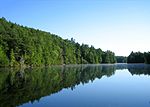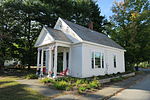Nipmuck State Forest
1905 establishments in ConnecticutConnecticut state forestsGeography of Tolland County, ConnecticutNipmuck State ForestParks in Tolland County, Connecticut ... and 3 more
Protected areas established in 1905State forests of the AppalachiansUnion, Connecticut

Nipmuck State Forest is a Connecticut state forest. Its 9,000 acres (3,600 ha) surround Bigelow Hollow State Park in the town of Union and include parcels in Stafford, Ashford, and other towns. The forest is part of a larger network of forest lands making up some 40,000 acres (16,000 ha) in all.
Excerpt from the Wikipedia article Nipmuck State Forest (License: CC BY-SA 3.0, Authors, Images).Nipmuck State Forest
Geographical coordinates (GPS) Address Nearby Places Show on map
Geographical coordinates (GPS)
| Latitude | Longitude |
|---|---|
| N 42.014166666667 ° | E -72.173611111111 ° |
Address
Union
Connecticut, United States
Open on Google Maps







